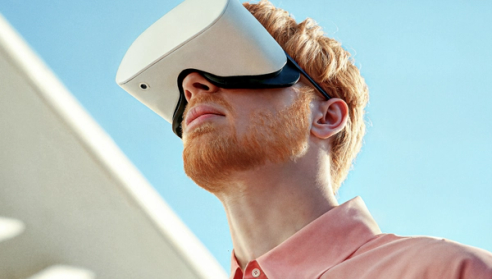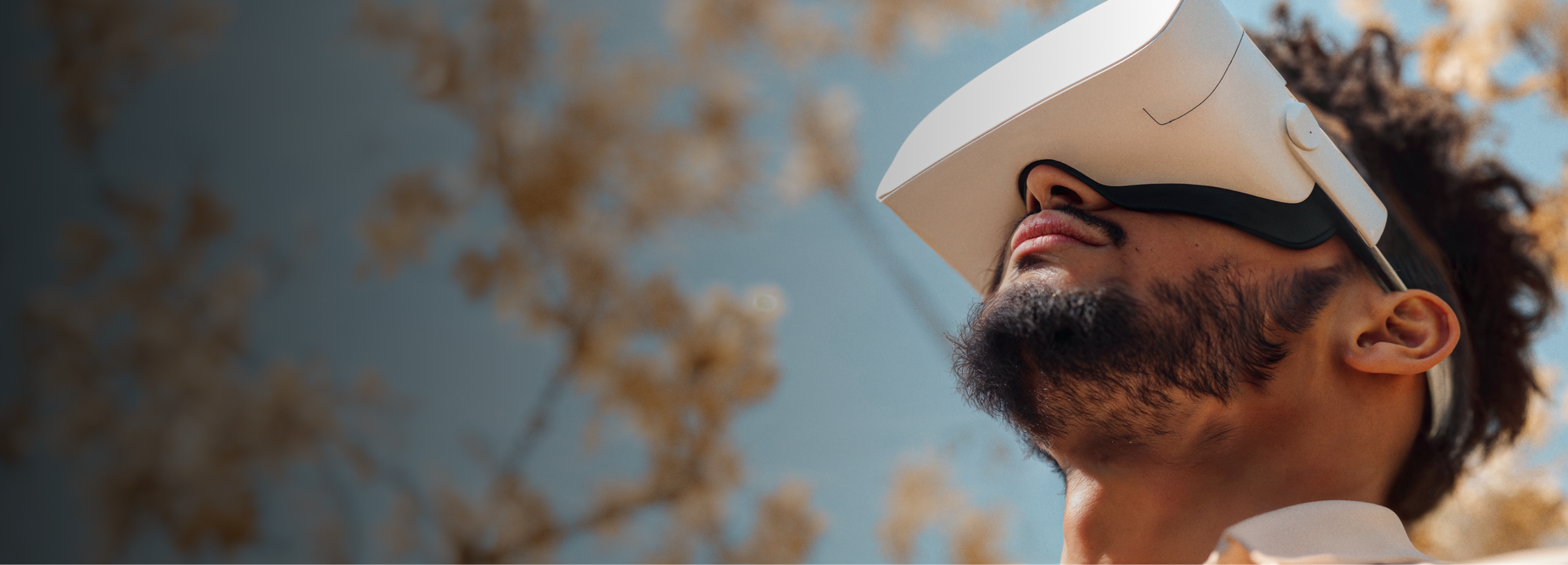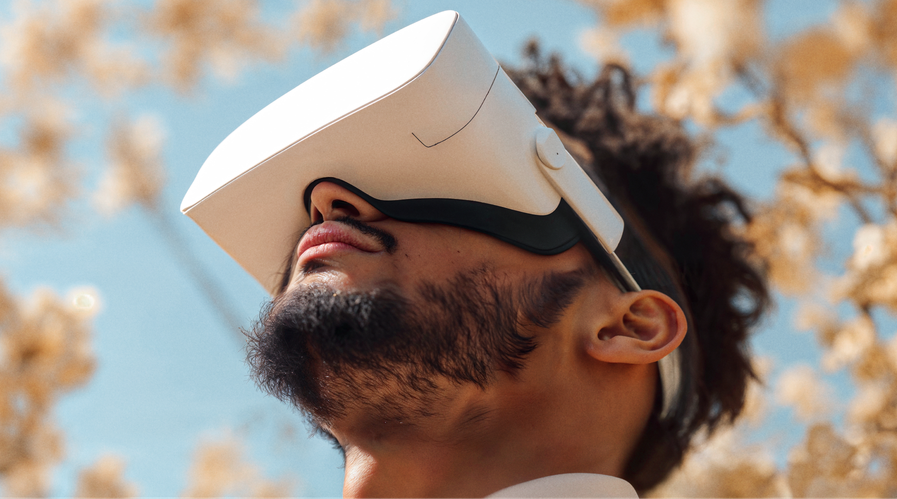A Total Guide to Augmented Reality (AR) Marketing & Design


Outline of chapters
Why Try AR


Is augmented reality (AR) something marketers and creatives really need to be thinking about?
To many, AR may seem too new or even a bit gimmicky. But lift the lid even a little and the case for AR marketing makes itself. Not only is the market opportunity massive, investing in this technology now will set your brand up for the immersive future.
And even at this arguably early stage, the results are inarguable. Dig into this AR marketing and design guide, and in addition to plenty of proof, you’ll discover:
- How AR works (in simple, practical terms)
- AR marketing examples across B2B and B2C
- Best practices and the AR design process
- AR design tools to help you get started
But first thing’s first, let’s get on the same page by defining AR. A step further than 3D design, yet a step removed from virtual reality (VR), AR keeps one foot in the physical realm while planting the other in an immersive experience. Sounds complicated? If you’ve ever taken a selfie or used a filter, you’re familiar with the mechanics already…
What is Augmented Reality (AR)?
AR is a technology that overlays computer-generated images on a user’s view of the real world, in real time. Whereas virtual reality (VR) is a completely fabricated experience, AR combines a user’s actual environment with virtual enhancements thus “augmenting” their reality.
That means, AR is experienced through a device, most commonly a mobile phone. By looking at the world through a device’s camera, users can see a composite view of real and superimposed virtual elements.
So, to understand what’s possible with AR, it can be helpful to think about it in terms of how mobile devices work. Most phone’s have a front camera, essential for selfies and FaceTime, and a back camera, for all your scenic photo and video needs. It follows that you can have both front and back camera AR experiences.
Front Camera (or Front-Facing) AR Experiences
If you’ve ever used a face filter on social, you’re already familiar with this type of experience.
Typically, front camera AR experiences involve a person’s face, hands or body. By tracking these features, it’s possible to overlay objects, like a Formula 1 helmet, or create more complex experiences through segmentation and live green screening. For instance, you could replace the background behind a person with a race track or mount their face on Lewis Hamilton’s body.
You can extract the face and mount it on new bodies and give people immersive, personalized experiences. Then they feel like they’re part of a brand experience, which gives them content they’re excited about and more likely to share. So off the back off paid media, we end up getting earned media as well.

Back Camera (or World-Facing) AR Experiences
If you’ve ever tried a piece of furniture out in a space using your phone, you’re familiar with this type of experience, too.
With back camera experiences, you’re generally adding virtual objects into a real world space. By tracking planes, like tables, walls and floors, it’s possible to place objects on those surfaces. Blurring the line between AR and VR, you can also create portals—doorways people can walk through to explore a virtual environment.
There are a range of different back camera experiences, but mostly we’re talking about plane tracking. We can track multiple different planes and place things on surfaces, which can work really well for trying out furniture. You can also mount a portal on a plane and have a doorway people can walk through and explore.

We’ll get into the nitty gritty of how AR actually works and what the design process entails a little later on. But in case you’re still wondering whether AR is worth it for your brand and what might slow you down once you commit, let’s talk benefits and challenges.
(And don’t worry, if you didn’t see yourself in these examples, we have a lot more of those coming your way too. Looking at you, B2Bers!)
The Benefits of AR Marketing
In marketing, first-mover advantage refers to the competitive edge you gain from being one of the first to bring a new product or service to market. Applying this terminology more broadly, you could say any new strategy has a first-mover advantage.
Think of HubSpot—the first to crack the code on inbound marketing—who’ve enjoyed over a decade of domination in the SERPs. Or, all the brands that had a field day when Facebook first launched its advertising platform before the rest of the industry caught up.
When it comes to AR, the time to move is now. Not only is there still a big opportunity to stand out by serving these experiences, adopting AR today will pave the way for a first-mover advantage tomorrow as more and more immersive technology comes online.
AR sets us up for a pathway to increased innovation, diving deeper and deeper as more technology comes online in the future. This helps us build our literacy as businesses in spatial AR experiences, so we can get more familiar with what it means to work in 3D, as well as accounting for interactivity and increasing levels of emotion.

Okay, you might say that sounds good in theory. But does the data add up? Absolutely.
The Challenges of AR Marketing
All these compelling proof points beg the question, “Why aren’t more brands investing in AR?”
The answer has to do with both perception and execution. Perhaps due to impressions left by flashy B2C campaigns, many brands don’t consider AR a serious marketing tactic. Or at least, not a tactic that makes sense for them.
Push past this prejudice and you may still encounter challenges in execution. From budget constraints to in-house skill gaps, let’s take a look at what you might be up against (and how to forge ahead).
If these hurdles gave you pause or you’re still wondering whether it’s the right time to jump on AR, give this video from our Associate Creative Director, Kyle Weber, a watch. He makes a case for adding AR to your marketing strategy sooner rather than later and dives into some compelling examples:
How Does AR Work?


AR can transform your environment, entice you to try products or take you through a portal to a whole new world.
But how does AR work, really?
It all starts with a camera-equipped device. To serve an AR experience, you first need to gather information on a user’s surroundings through a mobile phone, tablet or specialized device, like Meta’s Ray-Ban Smart Glasses.
Fortunately, modern devices have enough processing power to analyze the data needed to power AR. That includes inputs like depth, acceleration, position, tilt and light—in essence, everything the software needs to project an AR experience in a relevant location. A user can then interact with the AR experience in real-time, using touch, voice or gestures.
That means you have a lot more options when designing AR experiences. Rather than rely solely on static CTA buttons, you can empower users to indicate preferences with a tilt of their head or make decisions out loud, adding to the already engaging and immersive nature of this technology.
Of course, there are different types of AR software, some more accessible than others. And to an extent, what you can accomplish will depend on the AR development method and software you’re using. So, without getting too technical, let’s go over your options.
How Does AR Get Made?
AR takes the mantra “mobile-first” to a whole new level. As a technology primarily delivered on mobile, at least for marketing purposes, there are three different development methods to be aware of: App-based AR, web-based AR and social AR.
App-Based AR
Development platforms: Unity, Unreal Engine, ARKit, ARCore, Niantic Lightship
Like it says on the box, this approach involves developing a native AR app for iOS or Android. As you can imagine, creating an app from scratch is the most technically challenging method of implementing this tech, requiring deep knowledge of AR programming. There’s also the barrier of getting users to download your app in the first place.
That said, a custom app gives you the most control over the user experience, allowing you to tap into a device’s full capabilities and create complex interactions, animations and 3D models. All of these factors mean an AR app isn’t the best choice for a quick campaign or experiment—if you go this route, your app should support a long-term marketing plan.
With app-based AR, you have the most customization, but it’s also the most complicated and has the most friction since users need to download your app and you don’t have an audience built in.

Web-Based AR
Development platforms: AR.js, Niantic 8th Wall, Zappar, Snap Camera Kit
Web-based AR or web AR runs directly in mobile browsers, which removes the friction of having to download an app. From a development perspective, there are both benefits and challenges to this approach. On the one hand, the universality of web standards simplifies development. On the other hand, there are many limitations with browser-based technology.
Specifically, web AR may not offer the same depth of features you could get from a specialized app. You also need to account for different browsers and devices, as well as optimize for these experiences. All in all, there are some great use cases for web AR, primarily in ecommerce. Think trying on glasses or placing a life-sized purse on your desk, directly from a website.
Web AR is a little more complex than social AR, but it’s easier for the user to access information. You can jump from a QR code and open an experience in a browser, and you don’t need to be attached to a social network.

Social AR
Development platforms: SparkAR, EffectHouse, LensStudio (more on these tools later on!)
Last but not least, social AR is delivered through social platforms, like Instagram, Snapchat and TikTok, which means your audience is built right in. For development purposes, this is also the most user-friendly approach. All of these platforms provide AR tools, training materials and templates that make getting started with social AR simpler than web or app-based AR.
Nonetheless, there’s still a learning curve, and these tools do have some limitations. The main constraint? Size limits. On the plus side, this constraint ensures AR experiences are optimized for every user. All things considered, social AR is a great entry point for brands looking to experiment with this tech and has applications across both B2B and B2C, as we’ll explore next.
Social AR happens on TikTok, Snapchat and the Meta platforms, Facebook and Instagram. This means you have the reach and the community built in, but there are some limitations on what they will let you do.

AR for Business Examples


When you think of AR for business, your mind might gravitate towards the usual culprits.
IKEA’s room planner. Amazon’s virtual try-on app for shoes. Clearly’s web-based equivalent for glasses.
In other words, ecommerce or shopping use cases. With 70% of consumers saying AR makes shopping easier and 74% of brands in the commerce space reporting it improves customer loyalty and reduces returns, it’s no surprise this technology has high adoption rates in B2C.
But as we’ve alluded to, there’s a big opportunity for B2B brands to stand out, engage their audiences and drive results with AR, too. From delighting conference goers to driving virtual summit registrations, one of the biggest AR use cases for B2B is event marketing.
The biggest use case for AR—I would say 80-90% of our clients—come to us about events. They want to be brilliant at an event. They want their booth to be the one people speak about. They want attendees engaging with their content and so on.

How might AR help them accomplish these goals? Let’s take a look at some creative AR examples for both B2B and B2C, starting with events and following up with applications across advertising, product education, social media campaigns and more.
How Can B2B and B2C Brands Use AR?
1. Ceridian Dayforce stuns with an AR convention stand (B2B)
Type of AR experience: Surface tracker, portal - Social AR
Used for: An in-person event
Key objective: Enhance the brand presence during the convention
Ceridian Dayforce, a leading human capital management (HCM) software provider, wanted to stun attendees at their annual conference in Las Vegas. As their dedicated design partner, Superside stepped in to propose an AR stand filled with confetti galore that in-person conference goers could explore.
Using an AR filter, attendees could view a 3D compilation of product messages, testimonials and other brand elements, organized into an oval configuration to match the conference’s main meeting space. As brand experiences go, this one set the tone for an innovative event and helped Ceridian stand out in the densely populated tech industry.
Ceridian’s AR stand for conventions was a magical experience at their audience’s fingertips. Why settle for the ordinary when you can have an extraordinary augmented adventure?

2. AEI Consultants brings the future to life with AR imagery (B2B)
Type of experience: Target tracker - Social AR
Used for: An in-person event
Key objectives: Drive brand awareness during the event
AEI Consultants, a full service real estate consulting firm, was looking for ways to capture attendee attention at a high-value conference in Las Vegas. With Superside in their corner, they came up with the idea to mount scannable cards in the conference break room, a well-trafficked destination for their audience.
By scanning these cards, attendees were treated to a spellbinding AR experience, showing off scenes of sustainable futures that could be achieved by working with them. Featuring a blend of animated 2D and 3D elements, these AR experiences unfolded like a pop-up book, helping illustrate AEI’s environmentally-conscious mission and setting the brand apart.
Scanning each card transformed the images into a mesmerizing fusion of 2D and 3D animated wonders. The journey into AEI’s world just got a whole lot more spellbinding.

3. Superside builds event buzz with an AR head-tilt game (B2B)
Type of experience: Target tracker, face tracker - Social AR
Used for: A virtual event
Key objectives: Drive awareness and encourage registrations for the event
As a leading design services provider, Superside (A.K.A. yours truly!) is always looking for ways to push the envelope with our own creative promotions. So, when planning one of our recent virtual summits, Standout Creative That Performs, on the topic of video marketing, AR and more, we knew it was the perfect opportunity to flex our internal AR muscles.
To drive awareness for the event, we came up with a fun AR head-tilt game where users could answer a few questions and get a recommendation for a relevant summit session to attend. Easily accessible through Instagram, this 10-day AR advertising campaign generated over a million impressions, delivering on our goal of increasing awareness for the event.
This quiz with multiple possibilities was ideal for event and community engagement. We cranked up the visual appeal with this experience, even crafting some cool new functionalities.

4. SailGP reaches a wider audience with AR technology (B2C)
Type of experience: GPS-based technology - AR app
Used for: Live streaming an event
Key objectives: Increase accessibility and encourage viewership for events
SailGP, an international sailing competition and entertainment platform, wanted to find a way to make the sport more accessible to viewers around the world. Using cutting edge AR technology, they’ve made this vision come true. Through the SailGP app, anyone can access live streams of races featuring up to the minute insights and data from the event.
Through AR, they’re able to add an overlay to live races that tells the story of what’s happening on the course. In addition to fueling audience engagement, this approach is better for the environment—the virtual course markings leave no imprint on the ocean and sponsor logos are overlaid with none of the waste associated with real signage.
How do we make sailing understandable to anyone who tunes in as a casual viewer? Using live graphics, SailGP creates a stadium on the water and those graphics give meaning to what we’re doing.

5. Burger King burns down the competition with AR advertising (B2C)
Type of experience: Target tracker - AR app
Used for: OOH advertising
Key objectives: Drive brand awareness and sales
Burger King went rogue with an AR-powered campaign that hijacked its competitors' digital out-of-home (OOH) advertising spots. By using brand elements as markers, the fast-food chain developed an AR filter activated by its competitors’ ads. With the Burger King app, users could point their phones at these ads and burn them down.
As the flames died down, users were invited to share their experience in exchange for a free Whopper at their nearest Burger King. In this way, Burger King’s guerilla marketing play drove viral sharing action while also increasing sales. Delightful and ingenuous, this AR campaign went on to gain notoriety and earn free media coverage.
Users would scan a Burger King competitor ad, which was used as a tracking element. This activated the AR experience with huge flames burning the competitor ad down.

6. NHS illustrates the life-saving power of blood donations with AR (B2C)
Type of experience: Target tracker - AR app
Used for: OOH advertising
Key objectives: Raise awareness and encourage donations
The National Health Service (NHS) wanted to draw attention to the importance of blood donations and encourage new donors at the same time. With the help of their agency partner, they came up with the idea of creating a digital OOH campaign, leveraging AR technology to show the public what their donors really mean.
By placing a sticker on their arm and scanning it, people would see an AR overlay with a bandage, needle and tube through their phone. Blood would then flow down the tube and fill up a bag attached to a sick patient on a billboard. As the blood bag filled up, the sick patient would get better, illustrating the life-saving power of becoming a donor.
Through an AR experience, people could see blood coming out of their arm, directly affecting a sick person on a billboard. This made it very tangible what it means to donate blood.

7. Cisco (B2B) simplifies setup with an innovative AR app (B2B)
Type of experience: Target tracker - AR app
Used for: Product education
Key objectives: Improve information access and troubleshooting support
Cisco, one of the world’s largest IT product and service providers, needed to find a way to make its massive catalog of solutions more accessible. From installing new devices to troubleshooting existing ones, they knew their customers could use extra IT support to get the most out of their various products.
To address this need, Cisco developed a custom AR app, designed to walk customers through installing and fixing devices. By pointing their phone or tablet at certain Cisco devices, customers could access information about components as well as virtual walkthroughs, eliminating the need for training manuals, reducing friction and speeding up time to value.
This AR app made Cisco’s products a lot easier to use for customers. And whenever you can make things easier on your customers, that’s a success.

8. The CFWMS drum up the fun with an AR headphone filter (B2C)
Type of experience: Face filter, face tracker - Social AR
Used for: Social media campaign
Key objective: Elevate an event and drive brand awareness
The Canadian Forces Morale and Welfare Services (CFWMS) was hosting an event for ex-military and their families focused on well-being, fitness and having a good time. To add a special touch to the gathering, Superside developed a custom AR headphone filter, naming the experience after the event itself: “Discover Your Beat,” or in French, “Trouve Ton Rythme.”
Inspired by the event’s theme of personal identity, users could try four different headphone options and choose the best fit for their style. A fun, light-hearted way to drive sharing action, this campaign allowed attendees to express themselves, checking off the box of personalization while supporting CFWMS’s social presence online.
Each choice unveiled a tailored 3D model paired with a backdrop inspired by one of four awesome themes. Users could make a statement with the ultimate blend of style and sound.

9. Karol G brings the dance party to her fans with an AR avatar (B2C)
Type of experience: Surface tracker - Web AR
Used for: Social media campaign
Key objectives: Support the launch of a new album and delight fans
Karol G, a Columbian singer-songwriter, wanted to do something special for the launch of her new album. Superside’s suggestion? An AR avatar of the influential artist dancing to her latest beats. By tapping the filter while listening to her album, users could see a miniature Karol G spring to life in their space.
Featuring a mix of 2D text, 3D hearts, and of course, Karol G, this AR experience was just plain fun and brought the dance party right to listeners. This added interactivity deepened the already immersive experience of listening to Karol G’s album, delighting her fans and incentivising them to come back for more music (and moves!) over and over again.
By tapping any surface, listeners could watch Karol G spring to life and groove in their space. It’s a virtual dance party—just a tap away!

10. Ally Financial drives engagement with an AR monopoly game (B2C)
Type of experience: Target tracker - Web AR
Used for: Social media campaign
Key objectives: Drive brand awareness and stand out in a crowded field
Ally Financial, a digital financial services company, took a playful approach to driving brand awareness—one that would set them apart in the crowded and often traditional field of finance. They partnered with Hasbro to turn six American cities into live MONOPOLY® board games, promoting financial literacy along the way.
By placing over-sized MONOPOLY® tokens and property spaces throughout these cities, Ally created a real world AR scavenger hunt. Participants could use their phones to scan these squares, activate AR experiences and win prizes. With hundreds of thousands of participants, this campaign thrilled Ally’s audience, driving earned media and the awareness they were after.
This AR gaming experience had huge adoption with users even traveling city to city to try and get all the rewards possible. And that’s converted to a huge database for Ally Financial.

A Last Note on AR for Businesses
As you can see, the AR marketing possibilities extend far beyond your typical B2C shopping use cases. Taking into account the need for more immersive marketing and the possibilities that open up with virtual experiences, B2B brands would be wise to consider AR when strategizing events or any integrated campaigns for that matter.
Not only do these experiences foster engagement, they open the doors to a wider audience, more diverse partnership opportunities and global perspectives, promoting greater accessibility all around.
There are things you can’t do in person that you can do with immerse technology and really capitalize on globally. Not only does it increase global reach, but it expands the sponsorship opportunities.

Best Practices for AR Design


Feeling inspired to create your own AR experience?
The first step is to understand best practices. By starting with some strategic considerations, you can ensure you come up with an idea that makes sense for the medium—and gets the kind of brand lifting, recall boosting, audience delighting results we’ve talked about so far.
When it comes to AR, the rules are a bit different but the game is the same. In other words, core marketing principles, like prioritizing your audience and planning for the full user journey apply. But the possibilities for interactions with AR go far beyond your classic, static CTA button.
In a way, this makes it even more important to think through the experience thoroughly. The following AR best practices are a good place to start.
Best Practices for AR Experiences
Based on years of trial and error, Moller has found considering these five principles influences positive outcomes for AR.
1. Gifts Not Ads
The best marketing is value-driven and AR experiences are no exception. When thinking of concepts for these experiences, make sure you’re considering what your audience genuinely wants and enjoys, rather than trying to push a unidirectional brand message at them. Whether that’s a bit of entertainment, dash of delight or moment of clarity when choosing a product, find a way to create gifts not sales pitches.
Make sure you’re giving people an experience they want. Whether that’s a bit of entertainment because they’re feeling bored, or they’re in the market for new sunglasses and we want to make it as easy as possible for them to find the right pair.

2. End to End Journeys
It’s not enough to think up a cool idea for an AR experience. To get results, you need to think through the user journey from start to finish. Consider how people will discover the experience, what funnel stage they’ll be at in that moment, and what step you want them to take next. Generally, your AR experience will be part of a larger campaign, and that context is key for driving the right outcomes.
We often start thinking about AR, and say cool, we’ll design an AR experience that does this. But how do people enter that experience? Where do they come from? What does the AR ad media look like? And where is that situated within the campaign?

3. Tie to Business Objectives
Marketing 101: Keep business objectives top of mind. Is your goal to increase brand awareness, educate on a new product or drive actual sales? The funnel stage of your campaign will determine what type of AR experience is most appropriate. For instance, an interactive game, like Ally Financial’s campaign, made perfect sense to achieve their brand awareness goals, while Burger King’s AR ad capitalized on a well-placed coupon to hit sales objectives.
You definitely want to think about the business objective. Is it more upper funnel or more lower funnel? This will shape the particular approach you have, and indeed, the placements and product selection.

4. Keep it Simple
Just because you can trigger interactions through touch, voice and gestures in an AR experience, doesn’t mean you should! With all the possibilities this tech opens up, it can be tempting to go overboard. But you’ll get the best results if you keep things simple. Limit yourself to one or two interaction modalities, so you’re not overwhelming your audience with an overcomplicated AR experience.
Because it’s such a rich creative canvas, it’s always enticing to pack as much as we can in there. But keep those user journeys really simple. Have just one or two ways of interacting, rather than 10. Otherwise, people can get a little bit lost.

5. Is it Possible
There are a lot more possibilities with AR… but those possibilities aren’t endless. Depending on the AR development method you choose, there may be social or web browser limitations. So, before you get too invested in an idea, scope out how realistic it is. Can you find comparable examples? Are there templates in AR social tools you can use? If none of these exist, it may still be possible, but you’ll need to do further exploration or consult with an expert.
We need to ask ourselves, is it possible? None of this is magic. Ultimately, there are still things we can do in AR and things we can’t yet do. So, we just need to be really sure that we can actually do what we want to do.

With these best practices in mind, you’ll have a leg up when it comes time to actually design an AR experience. But what does that design process look like? We turned to Federico Perini, a creative on the AR team at Superside, to walk us through getting the job done. Though every creative team’s AR process may look a little different, here are some core steps to consider.
What Goes Into Designing an AR Experience?
Like all good creative, Perini’s AR designs start with a brief and a solid understanding of the client’s goals and vision. From these foundations, creativity flows…
1. Strategy
The first step in the AR design process is the same as for any creative project—nailing down a strategy. In alignment with Moller’s best practices, this entails setting clear objectives, researching solutions and assessing the lay of the land before formulating a plan. When it comes to AR, one of the most important things to understand is where a filter will be used.
For instance, if you’re creating an AR experience for an in-person conference that opens up a whole different realm of possibilities than if you’re planning a purely digital campaign. With in-person events, you could have a 3D stand or portal-based experience accessed by scanning a QR code. Similarly, you could trigger an AR experience through a t-shirt, flier or business card.
Again, the right solution will depend on your goals. But once you know those, you can get creative with concepting…
First thing’s first, we need to understand the goal and where the client will use the filter. Once we obtain this information, we can start concepting proposals that typically involve different types of AR experiences.

2. Concepting
Equipped with a strong rationale for the type of AR experience you’d like to create, you can start playing with concepts within that category. At this stage, it’s all about figuring out the details of the experience. Perini starts with wireframing and 2D sketches, exploring possible elements, interactions and user journeys.
At this stage, he also considers limitations, or as Moller would say, “What’s possible.” As discussed, there are different constraints across web and social AR, and you’ll need to optimize depending on the platform. For example, with social AR’s strict size limitations, your experience has to be under four megabytes, which is quite small.
That means, each element should be chosen with care (and kept simple!) before moving to production and the higher lift of 3D modeling.
Imagine a digital gallery. We’ll start with 2D sketches on paper or in Photoshop, and we’ll try to understand how we could create the best space with the most appealing elements. What animations we could add and what level of interactivity we want to implement.

3. Production
With final wireframes in hand, it’s time to commit to asset creation. This is where the connection between 3D design and AR makes itself known. By nature, AR experiences are largely three-dimensional, which means modeling 3D elements is essential to bring them to life. In some instances, you might mix 2D elements in, like we did for AEI Consultants’ event cards.
But in general, the brunt of the work will be 3D design and animation. The trick is turning these 3D models into AR experiences. Most often, Perini’s team uses SparkAR, Meta’s social AR platform, for this last step. As noted, SparkAR offers templates for common AR experiences, like face filters and surface trackers, which is more efficient than starting from scratch.
Once the AR software’s logic is applied, the last step is to make sure the final experience passes muster…
Typically, we use more 3D than 2D elements. So, I’ll start modeling all the 3D elements, and if needed, create all the 2D textures. Then, I would send all the 3D models to my colleague who would create the filter, the augmented reality structure, inside SparkAR.

4. Post-Production
If you’re creating a social AR experience, the last step will be to submit it for approval. When using SparkAR, this involves publishing your filter to Meta Spark Hub. Typically, approvals take a minimum of five hours and a maximum of 24. Since Meta checks if your filter adheres to optimization standards, this step builds quality assurance right into the process.
On the other hand, if you’re creating a more complex web AR experience using your own script, quality assurance may be a lengthier undertaking. At this stage, you could also iterate on your final experience, creating localizations or variations for testing. And of course, once you’ve shared your AR filter with the world, you’ll want to keep an eye on those metrics.
Once again, this is easiest to do with social AR, as Meta, Tiktok and Snapchat will pull data for you. More on how these tools work, coming up next.
Once we’re finished applying the augmented reality structure, we only need to upload the filter to Meta Spark Hub and wait for approval. Most of the time, it takes about five hours but approvals aren’t 100%. Around 40% of the time you may need to optimize further.

AR Design Tools & Resources


You might think creating AR experiences would require a whole new set of tools.
But in reality, the AR design toolkit doesn’t look that different from a typical creative tech stack. Depending on the AR development method you choose, you’ll need two to three extra tools on top of your usual suspects, like Adobe Photoshop and Midjourney.
Since we specialize in social AR, we’ll focus on the tools needed to bring these types of experiences to life. (If you’re interested in app or web-based AR, you can always refer back to the development platforms listed in chapter one!)
What Tools Do You Need to Design an AR Experience?
According to Perini, here are the key tools you’ll need to design a standout social AR experience.
Adobe Photoshop and Illustrator
Even in a post-Figma world, Photoshop and Illustrator have their place. When it comes to designing AR experiences, these classic tools will likely be your first stop. Before committing to 3D modeling, Perini develops his AR concepts in 2D using Photoshop and Illustrator. Depending on the AR design, he might return to these tools at later stages to refine supplementary 2D elements and textures..
We typically use Photoshop and Illustrator for the 2D concept phase when we’re sketching AR experiences and developing elements and also for 2D textures.

Midjourney
Midjourney has quickly become a staple in many design workflows. Though optional when creating AR experiences, Perini enjoys using it for the time savings. If the clients are on board with AI, he’ll use Midjourney to generate starter images he can then bring into Photoshop and manipulate, speeding up the concepting phase and fueling unique designs.
Midjourney is really a time saver because, as you may have guessed, you can write descriptions of what you want and obtain pictures quickly.

Blender or Cinema 4D
For the 3D modeling phase, you have a couple options. Blender, an open source tool for 3D animation and modeling, is free but may be harder to learn. Cinema 4D is a paid 3D tool, but it’s easier for beginners to pick up. Perini uses a combination of both since each tool has its perks. Blender offers a lot of flexibility, while Cinema 4D excels at motion graphics.
Our goal is to create the best 3D objects possible and enable the best interactions. We use Blender or Cinema 4D for 3D development.

Spark AR, Effect House or Lens Studio
This is where the AR happens. Since we’re talking social AR, there are three tools to be aware of: Spark AR, Effect House and Lens Studio. Spark AR is Meta’s AR toolkit, where you’d create filters for Instagram. Similarly, Effect House is TikTok’s AR tool and Lens Studio is Snapchat’s. All of these platforms offer training materials and templates for common AR experiences, like face filters and surface trackers.
Spark AR, Effect House or Lens Studio is the software that takes design elements and merges them into an augmented reality experience. Basically, it’s where the magic happens.

Microsoft Visual Studio
Depending on the complexity of the AR experience you’re creating and whether there’s a pre-existing template available, you may need to do some custom scripting. Perini reaches for Microsoft Visual Studio in these instances, though any integrated development environment (IDE) would do the trick. This is where things get a little more complicated! If you have a custom AR experience in mind but limited in-house scripting skills, look to the resource coming up next.
For more complex experiences where we need to write custom script, we’ll use Microsoft Visual Studio, but you can use whichever IDE you like best.

Stand Out From the Rest With AR


Often, augmented reality is seen as a niche area. Yet over the last two years, it’s reached a point of maturity where it should be considered within the general marketing stack.
As we’ve seen, the market is massive and will only continue to grow as major players are pouring a huge amount of investment into this technology. From Apple to Meta, big names believe in the immersive future—and the marketers and creatives that want to get ahead are getting onboard.
With the advent of AI and feeds more flooded than ever, marketers will need to shift towards mediums that can provide a deeper connection with their audiences and AR is the perfect place to start. And though it may seem like a resource heavy undertaking, in the long run, the investment is returned tenfold given the reusability of 3D designs; the basis of AR.
AR appears to be an expensive capability, and it actually is to build from scratch. But when you think of the reusability of 3D design across brand assets, it’s really not an expensive capability at all.

So, don’t let the resource conversation stop you from pursuing this strategy. Remember the brand lift, the lower cost per campaign and the priceless nature of delighting your audience in an increasingly crowded world. Because that’s how you'll stand out.
You May Also Enjoy:
- No, It’s Not “Too Early” for AR in B2B Marketing—Here’s Why
- 10 Augmented Reality Examples That Made Marketing Look Good
- 8 Best Augmented Reality Design Agencies in 2024
- How to Unlock New Market Opportunities With 3D and AR
- The Impact of 3D Motion Design and Next-Level AI Animation Techniques
- How and Why Brands Are Embracing Immersive Marketing (Examples Included)

















